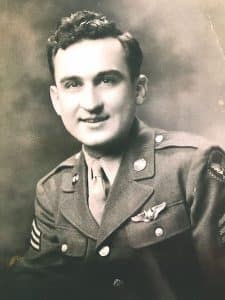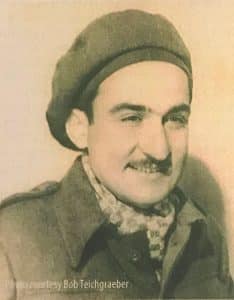WWII vet recalls POW ordeal

When he was in his 70s, Bob Teichgraeber of Collinsville went through some items he kept from his service during World War II.
Among those items was one of the few pictures of its kind: a photo of Teichgraeber, an American serviceman, in the uniform of another country’s military. In the picture, he is in a British uniform after being rescued by them.
Although he did not talk much about his experience in the war before revealing the rare photograph, Teichgraeber never forgot it.
“There are certain things you relive every day,” the now 99-year-old said. “They eat you up.”

escaping from being a prisoner of war for
421 days during World War II.
Teichgraeber’s grandfather, Louis, lived in Waterloo and served in the Civil War. He is buried in Waterloo City Cemetery with 99 other Civil War soldiers. Teichgraeber’s father was also born and raised here.
Teichgraeber followed in his grandfather’s footsteps after he was drafted into the U.S. Army Air Corps during WWII. He worked as a gunner.
More than half of Teichgraeber’s time in the military was spent as a prisoner of war, as he was held by German forces for 421 days.
He fell into enemy hands while part of the 445th bomb group, which was stationed near London in 1943.
On Feb. 24, 1944, Teichgraeber’s group flew a mission to bomb an enemy fighter factory in Gotha, Germany.
Teichgraeber’s plane, a new B-24 bomber, dropped its 2.5 tons of bombs on the factory, but the group missed its rendezvous with 200 fighter planes that were supposed to serve as protection.
Twelve of the 25 planes in Teichgraeber’s group were shot down before reaching their target, but it still decimated the factory and shot down 21 enemy planes.
About 10 minutes after dropping their payload, an enemy fighter plane attacked Teichgraeber’s aircraft, hitting the oxygen tank in the bomb bay.
The plane caught fire and went down.
Teichgraeber escaped the airplane before it crashed, but in doing so injured his foot when it hit a part of the plane as Teichgraeber jumped to avoid getting mangled in the wreckage.
Six members of his crew survived the encounter, but they were all captured by Germans.
Teichgraeber was taken to a triage center in Frankfurt to tend to his badly injured foot. When he left, he went with four members of his crew to a place called Stalag Luft VI, a German POW camp in present-day Lithuania.
The prisoners did not work in the camps, but some men began to lose their sanity.
“The hardest part was seeing guys breaking up and losing it in the camp,” Teichgraeber shared.
By June 1944, Teichgraeber could hear the guns of Russian allies approaching the camp. The Germans could too, so they moved their prisoners.
Teichgraeber and many others were put on a coal ship and sent to Stalag Luft IV in Poland.
“It was black as the ace of spades and really dirty,” Teichgraeber, who earned the Purple Heart for his foot injury, said of the ship.
Teichgraeber arrived in Poland in July and remained there until February 1945.
By that time, friendly forces were again nearing the camp’s position, so the Germans moved some prisoners westward on a journey that took about a month.
This march, which has been called one of the long marches or a hunger march, forces prisoners to sleep in freezing conditions in open fields or barns. There was hardly any food, and Teichgraeber weighed as little as 90 pounds during the march.
Hundreds of men died on these marches, and illness ran rampant among the POWs.
“It was rough sledding,” Teichgraeber, who turns 100 in about three months, recalled.
When the prisoners reached their destination, they were only there about six days before they returned east to avoid different allied forces approaching from the west.
Near the end of the 86-day, roughly 500-mile trek, the Germans stopped on the west side of the River Elbe, with British forces close behind them.
On the east side of the river, which they planned to cross the next day, was Russian territory.
“I knew that if we crossed the river we would be there until the war was over,” Teichgraeber said.
So, the next morning, a prisoner made a distraction after the Germans had already counted everyone. Teichgraeber and one of his friends quickly hid in the barn they were staying in and waited for the Germans to leave.
Once they did, Teichgraeber and his friend waited for friendly forces to arrive. They made their escape on April 15, 1945.
“The next day, the British came through,” Teichgraeber remembered. “They came to the river, but they didn’t cross it.”
Teichgraeber was with the English for about five days, during which time they gave him the spare uniform he was photographed in.
On the first day with the British, Teichgraeber and his friend realized they were now safe.
“We went through the chow line, then we went through the garbage cans,” Teichgraeber explained. “A British officer came and told us ‘you don’t have to do that.’ We were just starved.”
In addition to his Purple Heart, Teichgraeber was among the veterans honored at the 2016 dedication of the Purple Heart monument at Lakeview Park in Waterloo.
He still lives at home with his wife of 69 years. He still mows his own grass and drives himself.






